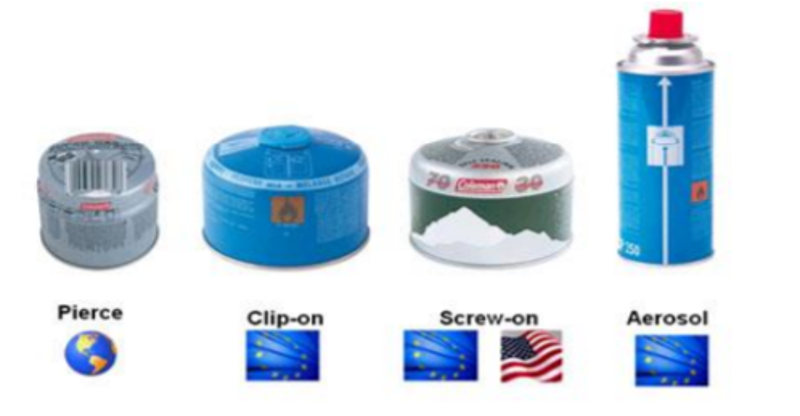Types of cartridges
Types of cartridges
Gas Cartridges
Most single burner gas stoves burn at around 150g/h (grams per hour). This is the rate at which the stove consumes fuel. This information will be found on either the packaging or the information booklet inside. By doing a simple calculation you will be able to make a rough estimate of how long the cartridge will last.
One litre of water should take around 3-6 minutes to boil. This is longer in colder temperatures, but shorter at altitude as all gas cartridges work better as altitude increases and air pressure is lower. Heat output declines as cartridge empties and pressure drops.
These cartridges are thrown away when empty and come in two main types –with an integral valve and pierceable - although there are numerous sizes and shapes of cartridge on the market. Please dispose of carefully. It is unlikely that they can be recycled in the ordinary way but check with your local authority centre.
Pierceable Cartridges - Scouts do not recommend you use these cartridges
Pierceable cartridges are fitted to the appliance once and cannot be removed without losing the gas inside. This increases the risk of fire or explosion if any ignition source remains.
Integral Valve Cartridges
Generally better and safer. They can be removed from the appliance because the valve reseals the cartridge, keeping the gas inside.
The most common of these have screw fittings that comply with EN417 type 2. This standard describes the fitting, so different sizes of cartridges are available for appliances of this type.
Aerosol Cartridges
Aerosol camping stoves are cheap and popular with all sorts of campers. We strongly advise you to take extra caution when using these types of stoves and always follow the manufacturer’s guidelines.
Some important tips to follow when using this type of stove:
- Explain to adults and young people about the potential hazards and how to deal with them.
- Ensure the collar of the canister is properly aligned and seated before using the locking lever.
- Discard the stove if it cannot be properly aligned and locked without effort.
- Have a bucket of water on hand to cool-down the stove and extinguish flames.
- Turn the stove off safely if you hear irregular hissing.
- Vacate the area in the event of a leak.
- Don't use this type of stove for cooking for long periods.
- Don’t use a pan larger than the ring size as the displaced flame may heat up the cylinder at the risk of explosion.
- Never leave a working stove unattended.
- Never attempt to turn off an over-flaming stove without protection to hands, arms and eyes.
Don't use this type of stove (indeed any gas stove) in a confined area where gas cannot escape freely.
The Scout Association has been made aware of several reports of the aerosols in these stoves exploding. In at least one case, the incident involved initial problems with the locking lever and gas control dial. Later the gas canister exploded. At this stage we cannot be certain of the exact cause but have learned that this type of equipment has been banned in certain parts of Australia. The apparent reason is overheating resulting in explosion.
Check out the additional guidance on using Aerosol Stoves.
